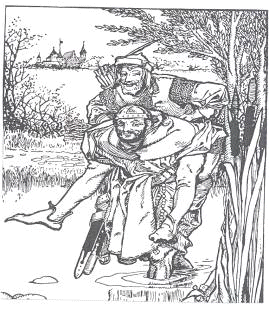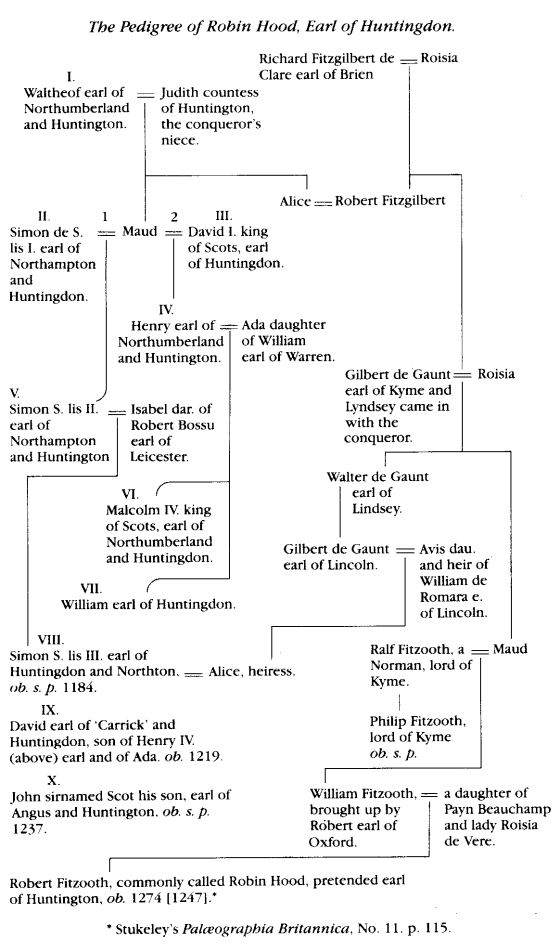The Later Story 2
 In the sixteenth and seventeenth centuries printers began to exploit the ‘mass’ market. Stories were printed in various forms, they could be broadsides, (single sheets printed on one side) or garlands, (anthologies) or chapbooks. (small books) Towards the end of the seventeenth century the broadside was in decline, this was replaced by the garlands. Most garlands contained between sixteen and twenty-seven different Robin Hood songs, printed in larger and more expensive books than the ordinary chapbook. Robin Hood and the Curtal Friar holds a prominent place in the Robin Hood Garlands, his famous battle with the curtal friar has been among the most popular of his many adventures. Another was Robin Hood and Little John, which tells how they meet on a long narrow bridge where they have a fierce encounter with the quarter-staff. Robin loses the battle and is tumbled into the brook. Robin Hood and Allen a Dale has Robin playing matchmaker, he rescues a young lady from an old knight she was going to marry and returns her to Allen a Dale. By the late seventeenth century many people could read and write, this spread the stories further.
In the sixteenth and seventeenth centuries printers began to exploit the ‘mass’ market. Stories were printed in various forms, they could be broadsides, (single sheets printed on one side) or garlands, (anthologies) or chapbooks. (small books) Towards the end of the seventeenth century the broadside was in decline, this was replaced by the garlands. Most garlands contained between sixteen and twenty-seven different Robin Hood songs, printed in larger and more expensive books than the ordinary chapbook. Robin Hood and the Curtal Friar holds a prominent place in the Robin Hood Garlands, his famous battle with the curtal friar has been among the most popular of his many adventures. Another was Robin Hood and Little John, which tells how they meet on a long narrow bridge where they have a fierce encounter with the quarter-staff. Robin loses the battle and is tumbled into the brook. Robin Hood and Allen a Dale has Robin playing matchmaker, he rescues a young lady from an old knight she was going to marry and returns her to Allen a Dale. By the late seventeenth century many people could read and write, this spread the stories further.
In 1746 Dr William Stuckley, the Lincolnshire antiquarian, gave Robin a false pedigree based on William Dugdale’s Baronage written in 1675. Stuckley added families and individuals that were fictitious; this became complicated, with Fitzooths and Fitzodos interwoven with the lords of Kyme and other families. He claimed Robert Fitzooth was commonly called Robin Hood pretended earl of Huntington. This confused Robin’s social status even further; in the early ballads he was simply a yeoman.

F.J.Child edited many of the Robin Hood ballads in the nineteenth century. As well as editing the earliest surviving versions, there are thirty-three later stories in his collection, some of them adapted from the earlier ballads. These include Robin Hood and the Bishop, Robin Hood’s Golden Prize, and Robin Hood and the Bishop of Hereford.
Sir Walter Scott portrays Robin Hood as Robin of Locksley in his book Ivanhoe, which was written in 1819. Robin helps the oppressed Anglo-saxons who are at odds with the Normans. This theme, was continued in 1825 by Augustin Thierry in his Histoire de la conquete de l’ angleterre par les normands. None of this was backed by evidence or proof; it was a continuation of the theories of John Major and Richard Grafton. In 1840 Pierce Egan wrote Robin Hood and Little John, one of the first stories written for children.
Robin Hood has appeared in films and television series and is now known all over the world. He has been portrayed by Douglas Fairbanks, Errol Flynn, Richard Greene, and more recently, Kevin Kostner and Russell Crowe. The story we know today has changed from what it was originally, the outlaw who fought injustice and gave to the poor was not part of the early stories, but this theme of a noble Robin Hood has become entrenched, and he will always be remembered as a hero.
The Later Story contains information found in Robin Hood, Holt, 1982; Rymes of Robyn Hood, Dobson and Taylor, 1976; Robin Hood: A Complete Study of the English Outlaw, Knight, 1994.

|